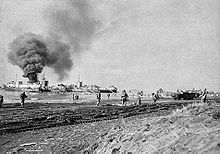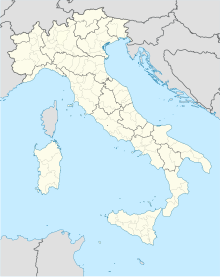
Back معركة أنسيو Arabic آنتسیو دؤیوشو AZB Битка при Анцио Bulgarian Desembarcament d'Anzio Catalan Vylodění u Anzia Czech Operation Shingle Danish Operation Shingle German Μάχη του Άντσιο Greek Batalla de Anzio Spanish نبرد آنتسیو Persian
| Battle of Anzio | |||||||
|---|---|---|---|---|---|---|---|
| Part of the Winter Line and the battle for Rome of the Italian Campaign of World War II | |||||||
 Men of the U.S. 3rd Infantry Division landing in late January 1944 | |||||||
| |||||||
| Belligerents | |||||||
|
|
| ||||||
| Commanders and leaders | |||||||
|
|
| ||||||
| Units involved | |||||||
| Strength | |||||||
|
Initially: 36,000 men 2,300 vehicles 2,700 aircraft[1] Breakout: 150,000 soldiers and 1,500 guns |
Initially: 337 aircraft[1] Breakout: 135,000 German soldiers and two Italian battalions | ||||||
| Casualties and losses | |||||||
|
43,000 men (7,000 killed, 36,000 wounded or missing)[2] |
40,000 men (5,000 killed, 30,500 wounded or missing, 4,500 prisoner)[2] | ||||||
Location within Italy | |||||||
The Battle of Anzio was a battle of the Italian Campaign of World War II that commenced January 22, 1944. The battle began with the Allied amphibious landing known as Operation Shingle, and ended on June 4, 1944, with the liberation of Rome. The operation was opposed by German and by Italian Repubblica Sociale Italiana (RSI) forces in the area of Anzio and Nettuno.[a][4]
Allied landings on the Italian mainland began in September 1943, and after slow gains against German resistance, the progress was stopped in December 1943 at the German defensive Gustav Line, south of Rome.[5]
The operation was initially commanded by Major General John P. Lucas, of the U.S. Army, commanding U.S. VI Corps with the intent to outflank German forces at the Winter Line and enable an attack on Rome.
The success of an amphibious landing at that location, in a basin consisting substantially of reclaimed marshland and surrounded by mountains, depended on the element of surprise and the swiftness with which the invaders could build up strength and move inland relative to the reaction time and strength of the defenders. Any delay could result in the occupation of the mountains by the defenders and the consequent entrapment of the invaders. Lieutenant General Mark W. Clark, commander of the U.S. Fifth Army, understood that risk, but he did not pass on his appreciation of the situation to his subordinate Lucas,[citation needed] who preferred to take time to entrench against an expected counterattack. The initial landing achieved complete surprise with no opposition and a jeep patrol even made it as far as the outskirts of Rome. However, Lucas, who had little confidence in the operation as planned, failed to capitalize on the element of surprise and delayed his advance until he judged his position was sufficiently consolidated and he had sufficient strength.
While Lucas consolidated, Field Marshal Albert Kesselring, the German commander in the Italian theatre, moved every unit he could spare into a defensive ring around the beachhead. His artillery units had a clear view of every Allied position. The Germans also stopped the drainage pumps and flooded the reclaimed marsh with salt water, planning to entrap the Allies and destroy them by epidemic. For weeks a rain of shells fell on the beach, the marsh, the harbour, and on anything else observable from the hills, with little distinction between forward and rear positions.
After a month of heavy but inconclusive fighting, Lucas was relieved and sent home. His replacement was Major General Lucian Truscott, who had commanded the U.S. 3rd Infantry Division. The Allies broke out in May. But, instead of striking inland to cut lines of communication of the German Tenth Army's units fighting at Monte Cassino, Truscott, on Clark's orders, reluctantly turned his forces north-west towards Rome, which was captured on June 4, 1944. As a result, the forces of the German Tenth Army fighting at Cassino were able to withdraw and rejoin the rest of Kesselring's forces north of Rome, regroup, and make a fighting withdrawal to his next major prepared defensive position on the Gothic Line.
The battle was costly, with 24,000 U.S. and 10,000 British casualties.[5]
- ^ a b Frieser 2007, p. 1148.
- ^ a b d'Este 1991, p. 490.
- ^ Almagià 1949.
- ^ Margaritis 2019, p. 103.
- ^ a b "Battle of Anzio | Date, Significance, & Summary | Britannica". www.britannica.com. 2024-03-22. Retrieved 2024-04-12.
Cite error: There are <ref group=lower-alpha> tags or {{efn}} templates on this page, but the references will not show without a {{reflist|group=lower-alpha}} template or {{notelist}} template (see the help page).
